The effects of plyometric jump training on lower-limb stiffness in healthy individuals:A meta-analytical comparison
Json Morn,Bernr Liew,Rorigo Rmirez-Cmpillo,Urs Grnher,Yssine Negr,Helmi Chene,e
a School of Sport,Rehabilitation and Exercise Sciences,University of Essex,Colchester,Essex CO43SQ,UK
b Department of Physical Activity Sciences,Universidad de Los Lagos,Osorno 5290000,Chile
c Division of Training and Movement Science,University of Potsdam,Potsdam 14469,Germany
d Higher Institute of Sport and Physical Education of Ksar Saı¨d University of Manouba,Tunis 2037,Tunisia
e High Institute of Sports and Physical Education of Kef,University of Jendouba,Jendouba 8189,Tunisia
Abstract Purpose:This study aimed to examine the effects of plyometric jump training(PJT)on lower-limb stiffness.Methods:Systematic searches were conducted in PubMed,Web of Science,and Scopus.Study participants included healthy males and females who undertook a PJT programme isolated from any other training type.Results: There was a small effect size (ES) of PJT on lower-limb stiffness (ES=0.33, 95% confidence interval (95%CI): 0.07-0.60, z=2.47,p=0.01). Untrained individuals exhibited a larger ES (ES=0.46, 95%CI: 0.08-0.84, p=0.02) than trained individuals (ES=0.15,95%CI: ‒0.23 to 0.53, p=0.45). Interventions lasting a greater number of weeks (>7 weeks) had a larger ES (ES=0.47, 95%CI: 0.06-0.88,p=0.03)than those lasting fewer weeks(ES=0.22,95%CI:‒0.12 to 0.55,p=0.20).Programmes with ≤2 sessions per week exhibited a larger ES (ES=0.39, 95%CI: 0.01-0.77, p=0.04) than programmes that incorporated >2 sessions per week (ES=0.20, 95%CI: -0.10 to 0.50,p=0.18). Programmes with <250 jumps per week (ES=0.50, 95%CI: 0.02-0.97, p=0.04) showed a larger effect than programmes with 250-500 jumps per week(ES=0.36,95%CI:0.00-0.72,p=0.05).Programmes with>500 jumps per week had negative effects(ES=-0.22,95%CI:-1.10 to 0.67,p=0.63).Programmes with>7.5 jumps per set showed larger effect sizes(ES=0.55,95%CI:0.02-1.08,p=0.04)than those with<7.5 jumps per set(ES=0.32,95%CI:0.01-0.62,p=0.04).Conclusion: PJT enhances lower-body stiffness, which can be optimised with lower volumes (<250 jumps per week) over a relatively long period of time(>7 weeks).
Keywords: Jumps;Stretch shortening cycle;Tendon
1. Introduction
High performance in activities that require a “bouncing”motion, such as running, jumping, and hopping, form a basis for success in both individual and team sports alike.At the tissue level, in movements such as these, the musculotendinous unit (MTU) exhibits spring- or elastic-like behavior whereby the MTU stretches as the lower limb joints undergo angular flexion before tissue shortening occurs as the joints extend.1,2In this way,the stretch-shortening cycle(SSC)is facilitated by the storage of elastic energy that is used to potentiate further movement beyond the movement that was initially executed.1
A key mechanical property governing the aforementioned spring-like behavior of musculotendinous tissue is the term“stiffness”.3Stiffness is calculated as the ratio of the applied force to the change in displacement of a body.3During spring-like movements, the individual stiffness values of various passive tissues(i.e.,ligaments,tendons)and active tissues(i.e., muscles) are integrated with neural contributions(e.g.,reflexes)to enable the musculoskeletal system to behave like a spring.4,5Stiffness can be quantified directly by using methods such as ultrasonography,6free oscillation,7sinusoidal perturbation,5quick release,8short-range stiffness experiments,9and the “alpha” method.10In addition, stiffness can also be quantified indirectly by using whole-body kinetics and kinematics,11-13although such variables would be more appropriately termed measures of quasistiffness.3
Lower limb stiffness can enhance performance in various athletic movements, such as vertical jumping,14endurance running,15sprint running,16and performances requiring a changing of direction.17This was demonstrated in a recent study16in which stiffness of the entire lower limb was shown to share significant relationships with key indicators of athleticism,such as maximal running velocity(r=0.74),squat jump height(r=0.51),and reactive strength index(r=0.44).In performing these movements,an athlete must repeatedly leverage the stretch-shortening cycle,which exploits the elastic characteristics of the MTU as it absorbs braking forces and generates propulsive forces.18This process exploits the aforementioned spring-like behavior of the MTU because the resultant kinetic energy facilitates faster locomotion.18
Different types of exercise can be used to target lower limb stiffness,19-21although current conclusions concerning the optimal form of training remain equivocal. For example,Kubo et al.22compared the effects of plyometric jumping and isometric resistance training on muscle and joint stiffness in previously untrained adult males.The authors reported that plyometric jump training (PJT), but not isometric training, improved direct measures of active plantarflexor muscle stiffness and indirect measures of joint stiffness during jumping actions. However, it has also been reported that changes in stiffness,but not in the pattern of muscle activation, accounted for the observed gains in jump performance following PJT in male participants aged 22 years of age.23The different results found in these studies, in addition to the conflicting findings in other investigations that have reported significant improvements22,24-26or no change at all,23,27show that there is currently no clear consensus in the current body of literature about on the effect of PJT on measures of stiffness.
Where different types of exercise are considered effective in enhancing stiffness, this may, in part, be due to variations in total training volume or dosage,which includes factors such as the number of sessions,repetitions,and sets and the time spent under muscular tension.28For example, it has been shown that exercise that induces higher levels of strain is more effective for increasing stiffness,29with minimal loading durations, at 90%of maximal voluntary contraction, shown to be around 3 s per repetition. In terms of traditional forms of training for performance enhancement,higher levels of strain are,therefore,more readily achievable with traditional resistance training than with PJT. Nevertheless, as evidenced above, this does not exclude PJT as an effective mechanism for enhancing direct and indirect stiffness, and PJT seems to remain a promising method for enhancing these qualities. To our knowledge, the effects of PJT on direct and indirect measures of lower limb stiffness have not yet been examined in the form of a comprehensive pooled analysis, which could help to gauge the actual level of effectiveness of PJT in enhancing this particular physical quality. Accordingly, to better understand the effectiveness of PJT on lower limb stiffness, we undertook a comprehensive meta-analysis.
We aimed to examine the effects of PJT on lower limb stiffness in healthy individuals.We also aimed to establish the characteristics of the dose-response between PJT variables(e.g., training volume, duration, and frequency) and lowerlimb stiffness, with a view to optimising training prescription guidelines for coaches.
2. Methods
This meta-analysis was conducted in accordance with the Preferred Reporting Items for Systematic Reviews and Meta-Analyses(PRISMA)statement.30
2.1. Literature search
With no date restrictions,a systematic search was conducted in the electronic databases PubMed (including MEDLINE),Web of Science,and Scopus.Keywords were collected through experts’opinions,a systematic literature review,and controlled vocabulary (i.e., Medical Subject Headings (MeSH)). Boolean search syntax, using the operators “AND” and “OR” was applied, in various combinations, to the following terms:“ballistic”, “complex”, “explosive”, “force-velocity”,“plyometric”, “stretch-shortening cycle”, “jump”, “plyometric exercise”,“resistance training”,“training”,“muscle”,“tendon”,“musculotendinous”,“compliance”,“elasticity”,“viscoelastic”,and “hysteresis”.Only original articles written in English were considered.Although we used the default values of the database search engines, manual data checking was also performed to increase the precision of data collection from relevant studies.
2.2. Selection of retrieved articles
After an initial search,accounts were created in the relevant databases.Through these accounts, we received automatically generated E-emails for updates regarding the search terms used. Thus, our search in the 3 databases was ongoing, with updates received on a weekly basis. Studies were eligible for inclusion until the initiation of manuscript preparation in July 2020.
2.3. Inclusion criteria
To determine the eligibility of studies for inclusion in our meta-analysis, we used the PICOS (participants, intervention,comparators, outcomes, and study design) framework.30The PRISMA flow diagram illustrating the number of studies excluded at each stage of the systematic review and meta-analysis is shown in Fig. 1. Inclusion and exclusion criteria are shown in Table 1, and the characteristics of the included studies are displayed in Table 2. For PJT intervention studies that were identified as being potentially relevant, the full text was used to determine if the study contained a relevant measure of stiffness,as stipulated in Table 1.Lower limb stiffness can be assessed using either direct measures, such ultrasonography,29,31or indirect measures using kinetics and/or kinematics.11
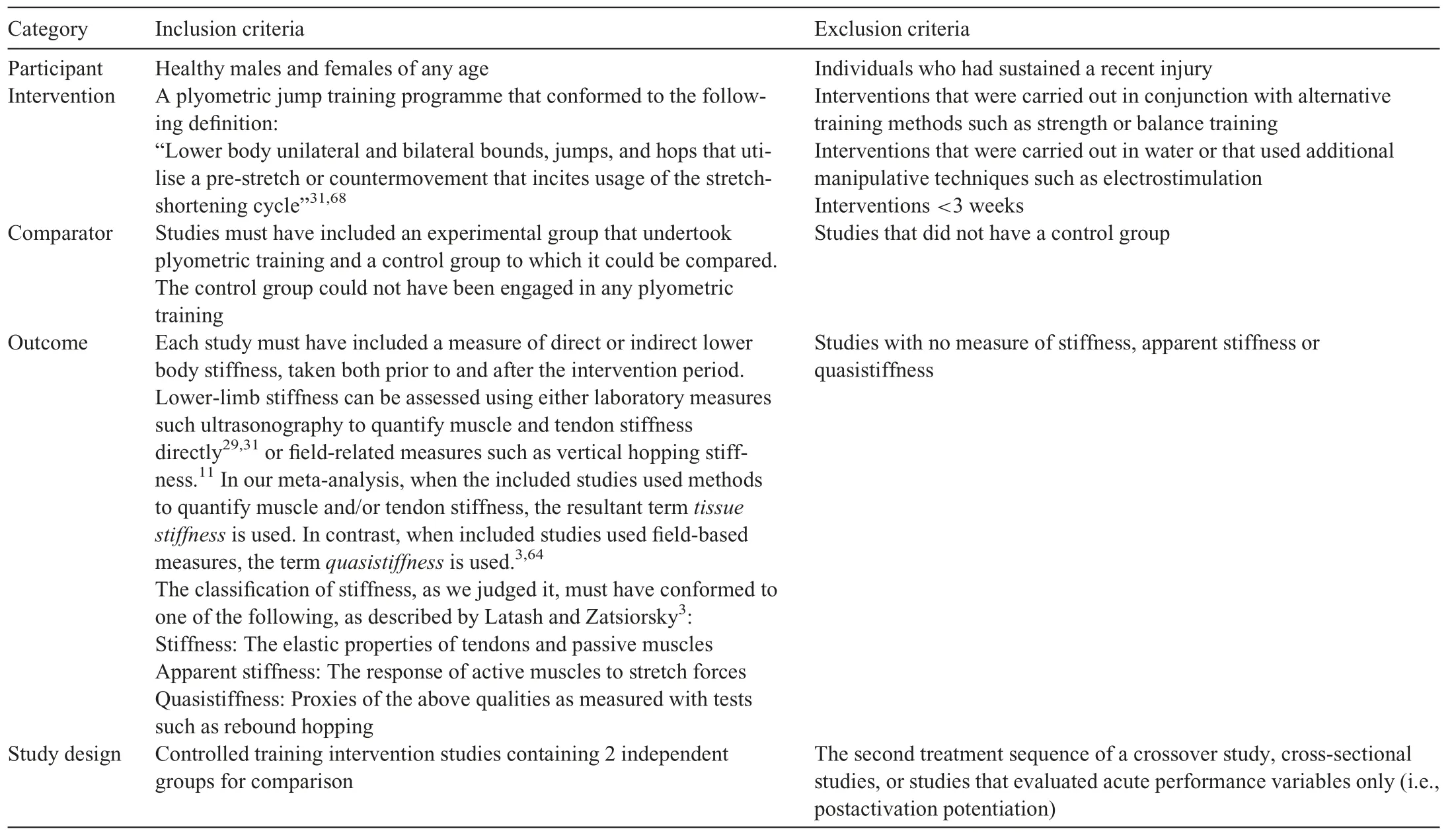
Table 1 Participants,intervention,comparators,outcomes,and study design(PICOS)framework for study inclusion and exclusion criteria.
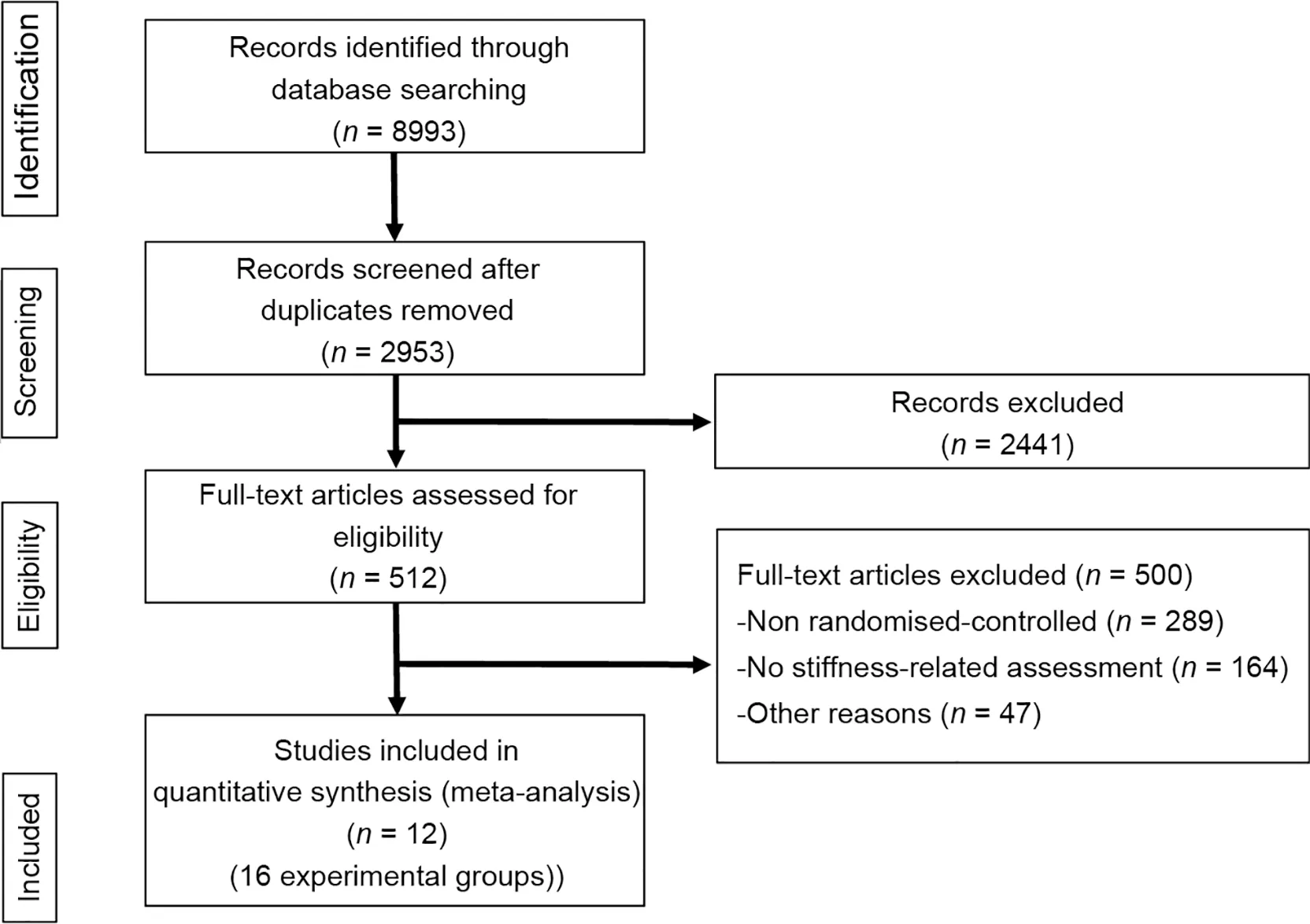
Fig.1. Flow chart for inclusion and exclusion of studies.
2.4. Analysis and interpretation of results
Data were extracted from included articles with a form created in Microsoft Excel.Where required data were not clearly or completely reported, the article’s authors were contacted for clarification.Meta-analytical comparisons were carried out in RevMan Version 5.3.32Means and SD for measures of stiffness were used to calculate an effect sizes. The inverse-variance random-effects model for meta-analyses was used because it allocates a proportionate weight to trials based on the size of their individual standard errors33and facilitates analysis whilst accounting for heterogeneity across studies.34Effect sizes (ESs) are represented by the standardised mean difference and are presented alongside 95% confidence intervals (95%CIs). The calculated ESs were interpreted by using the conventions as outlined by Hopkins et al.35(<0.19=trivial,0.19 to <0.59=small, 0.59 to <1.19=moderate, 1.19 to<1.99=large, 1.99 to <3.99=very large, ≥3.99=extremely large). In cases in which there was more than one intervention group in a given study, the comparison group was proportionately divided to facilitate comparison across all participants.36
To gauge the degree of heterogeneity amongst the included studies, the I2statistic was calculated. This represents the proportion of effects that are caused by heterogeneity as opposed to chance.30Low,moderate,and high heterogeneity correspond to I2values of 25%, 50%, and 75%, respectively; however, these thresholds are considered tentative.37A value>75%is rated as being considerably heterogeneous.33The x2(chi-square) is assessed if any observed differences in results are compatible with chance alone.A low p-value,or a large x2statistic relative to its degree of freedom,provides evidence of heterogeneity of intervention effects beyond those attributed to chance.33
2.5. Assessment of risk of bias
The Physiotherapy Evidence Database (PEDro) scale was used to assess the risk of bias and methodological quality of the included studies. This scale evaluates internal studyvalidity on a scale from 0(high risk of bias)to 10(low risk of bias). Two reviewers (HC and YN) independently rated each study. Any ratings that yielded different results between the 2 reviewers were further adjudicated by a third reviewer(UG),a course of action that did not have to be followed. The agreed rating was used in the risk of bias scale.A median score of ≥6 represents the threshold for studies with a low risk of bias.38

?
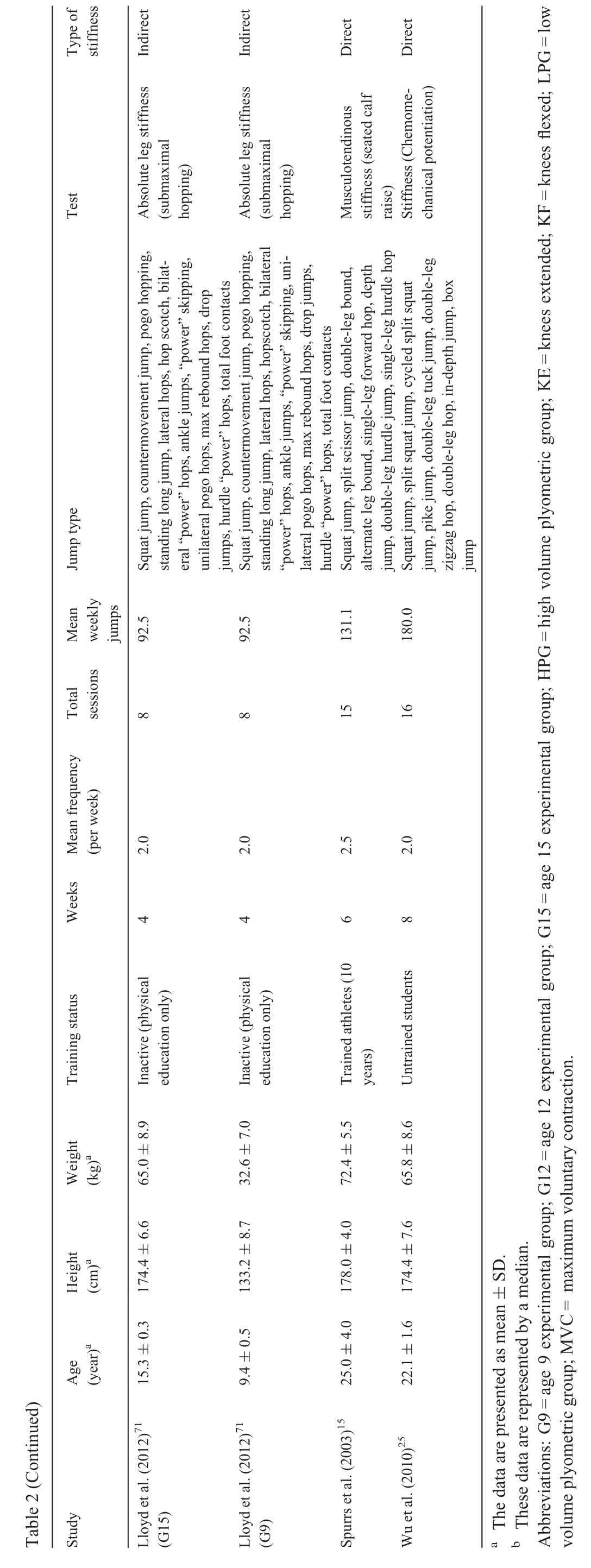
2.6. Analysis of moderator variables
To assess the potential effects of moderator variables, subgroup analyses were performed.We selected,a priori,moderators likely to influence the main effect of PJT on stiffness.For this,a subgroup division between direct and indirect measures of stiffness was made. Indirect stiffness is that which can be quantified using whole-body kinetics and kinematics11-13and can be alternatively termed quasistiffness because it does not necessarily evaluate the mechanistic elements of this physical quality.Conversely,direct stiffness,which is representative of localised passive stiffness in anatomical structures such as the Achilles tendon,39is that which is quantified with methods such as ultrasonography,6free oscillation,7sinusoidal perturbation,5quick release,8short-range stiffness experiments,9and the “alpha” method.10Other subgroups included the number of weeks in the applied programme,the total number of training sessions, and the weekly frequency of those sessions.These variables were chosen based on the accepted influence of the FITT(frequency,intensity,time,and type)principle on adaptations to exercise.40The median number of sets and repetitions per exercise were chosen on the basis of their use in previous PJT meta-analyses.41A cumulative total of mean weekly jumps was also used as a moderator.The training status of the study participants was considered due to the presence of an upper threshold of adaptation to exercise after a particular level is achieved.42For this moderator,study participants were divided into “trained” and “untrained” subgroups, with athletes, active individuals, and those with >1 year of training experience considered for the former group and inactive and recreationally trained individuals allocated to the latter. For these classifications, we depended on the study authors’ own assessment of the level of activity undertaken by participants in their study.We did not,however,consider children engaged in physical education only as “active”.For all other variables,a median, or “natural split”, was used to divide subgroups,whereby clear divisions in the data were identified and used as a delineator. For example, the most logical division of mean weekly jump total resulted in the formation of subgroups of<250 jumps, 250-500 jumps, and >500 jumps per week.This constitutes a more intuitive division,where indiscriminate use of the median split would be inappropriate.
3. Results
3.1. Study selection
The PRISMA flow diagram illustrating the number of studies excluded at each stage of the systematic review and metaanalysis is shown in Fig. 1. Together, the studies wereconsidered to be at low risk of bias (median quality score=6.0). These data are presented in Table 3. In total, 12 studies,with 16 experimental groups,met the inclusion criteria and were included in the systematic review. A total of 7 of these groups incorporated measures of indirect stiffness,and 9 of them incorporated measures of direct stiffness.

Table 3 Physiotherapy Evidence Database(PEDro)scale ratingsa
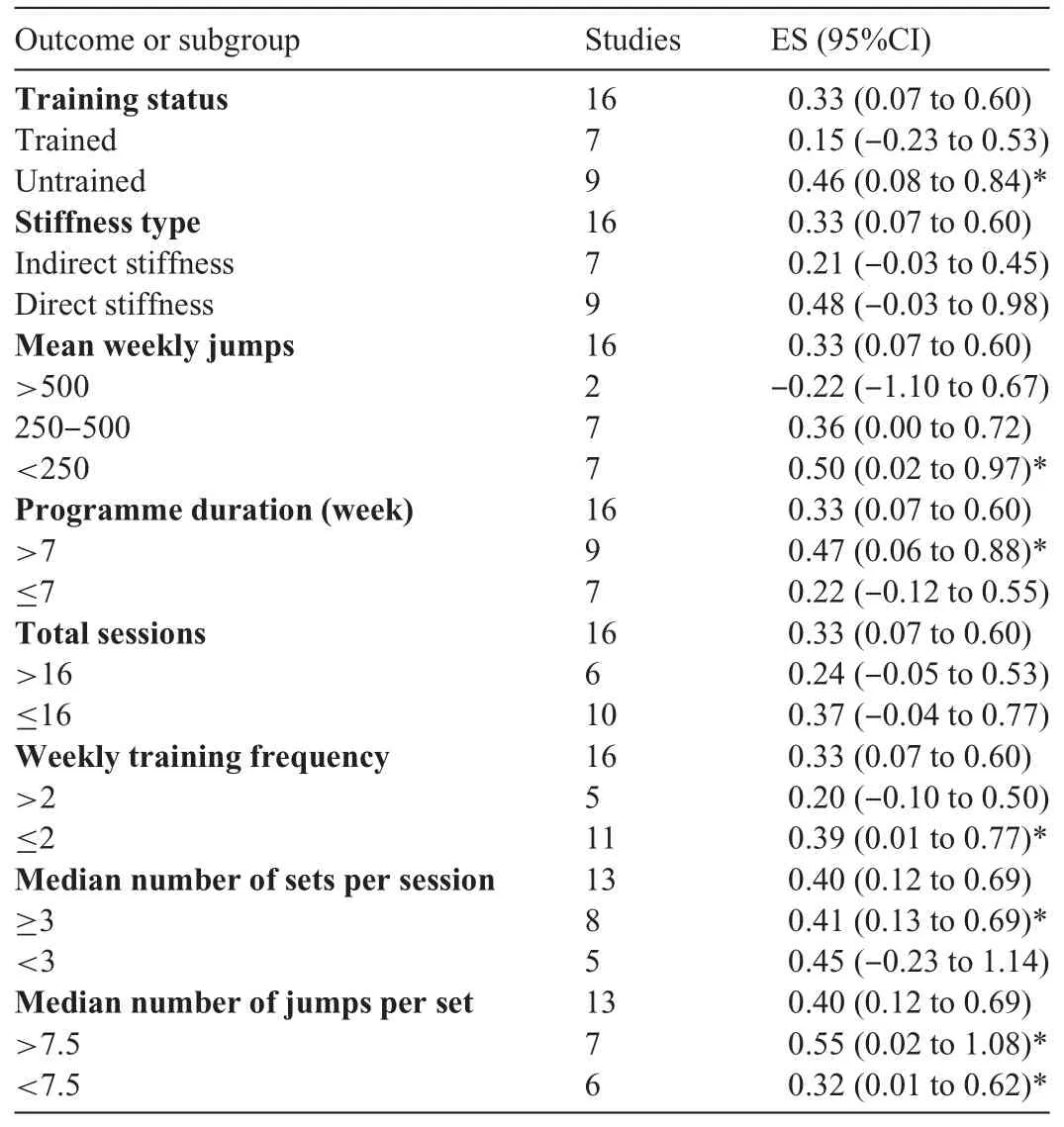
Table 4 Moderator analyses for the effect of plyometric training on tendon stiffness.
3.2. Primary analyses
For the main effect analysis on the effect of PJT on lower limb stiffness, there was a small effect size (ES=0.33,95%CI: 0.07‒0.60, z=2.47, p=0.01). Between-study heterogeneity was moderate (I2=38%, p=0.06). These results are displayed in Fig.2.
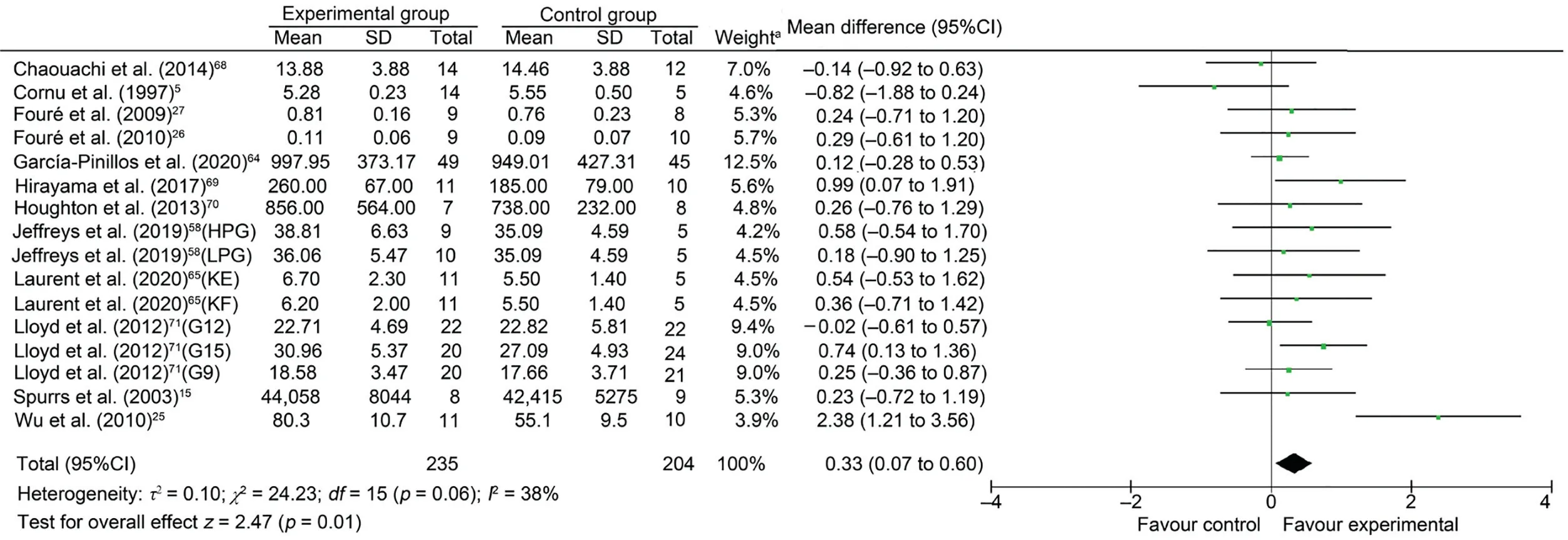
Fig.2. Forest plot of main effect of plyometric training on lower-limb stiffness.a The sum of the percentages is not 100%due to the rounding.95%CI=95%confidence interval; G12=age 12 experimental group; G15=age 15 experimental group; G9=age 9 experimental group; HPG=high volume plyometric group;KE=knees extended;KF=knees flexed;LPG=low-volume plyometric group.
3.3. Effect of moderator variables
The results of the moderator analysis are displayed in Table 4. Differences between subgroups demonstrated low heterogeneity and were non-significant. For training status,“untrained” individuals exhibited a small effect (ES=0.46,95%CI: 0.08-0.84, p=0.02), whereasile no effects were observed for “trained” participants (ES=0.15, 95%CI: -0.23 to 0.53,p=0.45).For test type,those tests for direct measures of stiffness showed a small effect(ES=0.48,95%CI:-0.03 to 0.98, p=0.06) that exceeded the borderline trivial to small effect for indirect measures of stiffness (ES=0.21, 95%CI:-0.03 to 0.45,p=0.09).For programme duration,those interventions lasting a greater number of weeks (>7 weeks) displayed a larger (ES=0.47, 95%CI: 0.06-0.88, p=0.03) than those lasting a lower number of weeks (ES=0.22, 95%CI:‒0.12 to 0.55, p=0.20). A contradictory trend was seen for total sessions per programme, with programmes having ≤16 sessions showing a larger (ES=0.37, 95%CI: -0.04 to 0.77,p=0.08), though still small, effect compared to its opposite subgroup (ES=0.24, 95%CI: ‒0.05 to 0.53), p=0.11). Similarly, programmes with ≤2 sessions per week exhibited a larger effect size (ES=0.39, 95%CI: 0.01-0.77, p=0.04)than programmes that incorporated >2 sessions per week(ES=0.20,95%CI:‒0.10 to 0.50,p=0.18).This trend is also apparent in the subgroups for number of jumps per week,with<250 jumps(ES=0.50,95%CI:0.02-0.97,p=0.04)showing a larger effect than 250‒500 jumps (ES=0.36, 95%CI:0.00-0.72,p=0.05),which was,in turn,larger than the negative effect size for>500 jumps per week(ES=‒0.22,95%CI:‒1.10 to 0.67,p=0.63).Interventions with>7.5 jumps per set showed a larger effect size (ES=0.55, 95%CI: 0.02-1.08,p=0.04) than interventions with <7.5 jumps per set(ES=0.32, 95%CI: 0.01-0.62, p=0.04). Interventions with≥3 sets or <3 sets displayed similar effect sizes (ES=0.41,95%CI: 0.13-0.69, p=0.04 vs. ES=0.45, 95%CI: ‒0.23 to 1.14,p=0.20,respectively).
4. Discussion
This meta-analysis examined the effects of PJT on lower limb stiffness in healthy males and females. The main results indicate that PJT can induce small but statistically significant increases in lower limb stiffness.Of potentially greater interest to practitioners are the results of the subgroup analysis,which demonstrated a non-uniform pattern of adaptation across populations. Of potentially greater interest to practitioners are the results of the subgroup analysis, which demonstrated a nonuniform pattern of adaptation across populations with untrained individuals,the programming of a greater number of jumps per set, and an upper weekly limit of 250 jumps were some of the key factors to positively influence effect magnitude positively.
4.1. Main effect
Mechanical loading of the MTU results in increases in tendon stiffness due to enhanced collagen synthesis.43,44Such loading can enhance both the size and the mechanical characteristics of the tendon,44but the nature of these changes is dependent on the type of loading that is habitually applied.45Indeed,this may be why conclusions in the literature related to the effectiveness of PJT for the enhancement of tendon stiffness have been equivocal. Two reviews,45,46whilst acknowledging the propensity of PJT to enhance tendon stiffness,reported similarly results, with these inconsistencies’ possibly being explained by differentials in adaptive potential across various anatomical structures in the body or by differentials in active and passive components of the musculotendinous complex.22Hypertrophic gains of up to 35% in tendon tissue are possible in adults.45However,it seems that such changes,and subsequent increases in tendon stiffness, are more likely to occur due to traditional resistance training rather than PJT.23This could be because the comparatively smallower amount of time spent under an applied force (or tension) during PJT47may not be sufficient to induce a hypertrophic response48,49and,by extension,an increase in tendon stiffness.Thus,resistance training, and, in particular, its eccentric variant, may be a more appropriate stimulus for achieving stiffness-related adaptations.50
Although PJT can be readily utilised to enhance tendon stiffness, it may not necessarily represent the optimal method with which to drive such adaptation, through hypertrophic pathways at least.This is supported not only by the existing literature but also by the small magnitude of the main effect in our meta-analysis, which suggests that a potentially low level of change in stiffness occurs due to PJT, particularly in the short term.To understand this small effect size,the multidimensional nature of sports performance must be considered. For example,the attainment of muscular strength is underpinned by various interdependent pathways of adaptation relating to neurological and morphological changes.51There is a differential in the time it takes for muscle and tendon tissue to adapt to training, with PJT seeming to preferentially stimulate adaptations in muscle tissue as opposed to tendons.45Also, increases in muscle strength seem to be more sensitive to neuromuscular training stimuli in that they have been found to precede increases in tendon stiffness by up to 2 months.21,52The average duration of the studies included in our meta-analysis was just 7.5 weeks,indicating that even if tendon stiffness were assumed to be highly achievable through PJT, the time course of the included studies may not have been of sufficient duration to allow this phenomenon to be observed. This is supported by our finding that programmes lasting >7 weeks produced a two-fold greater magnitude of effect compared to programmes lasting ≤7 weeks.Accordingly,until longer-term interventions that examine the effects of PJT on tendon stiffness are undertaken, definitive conclusions concerning their true effect will be difficult to make. Indeed, this variance in duration could be this reason that discrepancies exist in the results from studies on the potential to enhance stiffness through PJT.Long-term interventions would also be in line with the principles of athletic development programmes for youth participants (which accounted for nearly 30% of the study groups in our meta-analysis) and would better facilitate the assessment of potential imbalances in the development of muscle and tendon adaptations,thus reducing injury risk.45,53,54
4.2. Effect of moderators
With respect to the impact of moderators on the main effect,a notable result relates to the higher effect size observed in untrained, compared to trained, participants. This could indicate a pattern of adaptation that is characterised by a rapid onset of small changes in stiffness, with the potential for continued adaptation quickly reduced as an individual attains a larger body of training experience. This could potentially reduce the chances of further development in the longer term since the bulk of adaptive responses are seen in the early stages of training.In order to continue stiffness-related adaptations in more advanced athletes,29coaches may want to place a greater emphasis on traditional strain-inducing resistance training than on PJT, underpinning the importance of a multidimensional programme to achieve highly specific aims. This is an important consideration for coaches because advanced athletes, in particular, are accustomed to a “biological ceiling” in their development,beyond which further adaptations to training are reduced or negated.42Furthermore, coaches should be aware of the potential for mismatches in the time course of muscle and tendon adaptations, which can result in problematic outcomes for an individual. For example, an increase in muscle strength that occurs independent of any change in tendon stiffness can lead to higher tendon strain during maximal performance, culminating in an increase of the mechanical demand exerted on the tendons by acting musculature.55Thus,multidimensional programmes that concurrently develop the strength and stiffness of all tissues should be an integral component of athletic development.
Another notable moderator finding relates to the apparently inverse dose-response of PJT for the enhancement of stiffness.Mean weekly jumps in our meta-analysis were divided into low (<250 jumps), medium (250-500 jumps), and high(>500 jumps)load classifications.It is interesting to note that the higher the dose,the lower the observed effect.This inverse trend seems to imply that lower volumes of PJT may be more beneficial than higher volumes for the achievement of enhanced stiffness. Indeed, previous research lends support to this finding,with lower volumes of PJT found to be almost as effective and more efficient than higher volumes when jumping performance was measured.56,57A recent investigation58also revealed the effect of low and high volumes of PJT on the reactive strength index in collegiate rugby players.Across various measures of the reactive strength index,59larger effects were reported from different jump drop heights following lowvolume PJT (480 foot contacts) than following high-volume PJT(1920 foot contacts).58Although the results of these cited studies do not relate directly to a measure of tendon stiffness,they do lend weight to the notion of an upper limit to the effectiveness of larger volumes of PJT. As has been previously demonstrated,higher volumes of PJT are not universally optimal.60,61This could be further elucidated with additional research implemented over a longer period of time than the research cited in our meta-analysis.
The finding that lower volumes of PJT (<250 jumps) may be more beneficial for enhancing stiffness than higher volumes is further supported by our results, which indicated that programmes with ≤16 sessions were marginally more effective than programmes with >16 sessions. Furthermore, programmes with <3 sets of PJT were as effective as those with>3 sets, whilst lower training frequencies (≤2 sessions per week) were preferable to higher training frequencies (i.e., >2 sessions per week). These results imply that, alongside lower jump volumes within individual sessions, having fewer training sessions across a longer time frame may help to optimise adaptations for tendon stiffness, with higher doses seemingly not required to initiate adaptation in the short term. Coaches could, therefore, maximise tendon-stiffness adaptations by programming a lower frequency of PJT alongside low withinsession training volumes but over a higher number of training weeks.Such a programming structure would enable coaches to target stiffness specifically without compromising, through fatigue, the other training goals that must be achieved in a physical-preparation programme. A prudent training strategy,therefore, would include jumps that are specifically appropriate specifically for enhancing stiffness as a physical quality,including jumps those that require resistance to knee and hip flexion and short ground contact times,62such as ankle hops,skipping, hurdle hops, and depth jumps. Because in many cases these jumps are of low intensity,63they can regularly be incorporated into warm-up activities that conform to the low load of semiregular PJT,thus underpinning progression in this area.Coaches are encouraged to avoid having athletes engage in high volumes of PJT to achieve greater stiffness because this seems unnecessary and could be detrimental to an athlete’s conditioning.61
4.3. Limitations
Because there are some limitations to our study,our results should be interpreted with caution. Female participants were part of only 2 studies64,65in our meta-analysis;thus,the results of our review may not be fully applicable to that population.Also, because stiffness was measured and represented in the included studies in a number of different ways,it is not possible to conclude that the positive increases we report can be attributed to changes in muscle activity,mechanical properties of the MTU,or a combination of both.It has been shown that changes in muscle morphology and architecture can occur in as few as 3 weeks in response to resistance training, whilst rapid adaptations of tendon morphological or mechanical properties seem unlikely.45Additionally, in our moderator analyses, the dichotomisation of continuous data with the median split could have resulted in residual confounding and reduced statistical power.66,67Finally, the moderator analyses were calculated independently and not interdependently.Such univariate analysis must be interpreted with caution because the programming parameters were calculated as single factors,irrespective of between-parameter interactions.
5. Conclusion
Based on the pooled data presented in our meta-analysis,PJT can be used as an effective method that coaches can use to enhance direct and indirect stiffness in healthy males and females. However, based on the wider body of evidence, PJT may not be the best way to enhance stiffness and may be better utilised as a complementary method for enhancing it, alongside potentially more effective methods, such as traditional resistance training or eccentric resistance training. The time course of adaptation is also an important factor to consider;programmes lasting longer than 7 weeks are more effective.This could be directly related to the relative responsiveness of tendinous tissue compared to muscle tissue;the latter seems to adapting faster to neuromuscular training stimuli. Balancing the training volume is key because weekly loads >500 jumps may be deleterious to enhancing stiffness,and the need to prescribe sustained volumes that are optimal but not excessive is apparent. Thus, the prescription of <250 jumps per week seems optimal for the enhancement of stiffness. Complicating these recommendations is the training status of the individual.Therefore, coaches are encouraged to remain mindful that small gains in stiffness that can be attained through PJT are likely to be subject to diminishing returns over time. This necessitates the prescription of multidimensional physicalpreparation programmes that enhance stiffness via alternative pathways of adaptation.
Authors’contributions
JM collected the data, analysed the data, and wrote the manuscript; BL analysed the data and wrote the manuscript;RRC collected the data and wrote the manuscript; UG analysed the data and wrote the manuscript;YN analysed the data and wrote the manuscript; and HC conceived the study, analysed the data,and wrote the manuscript.All authors have read and approved the final version of the manuscript, and agree with the order of presentation of the authors.
Competing interests
The authors declare that they have no competing interests.
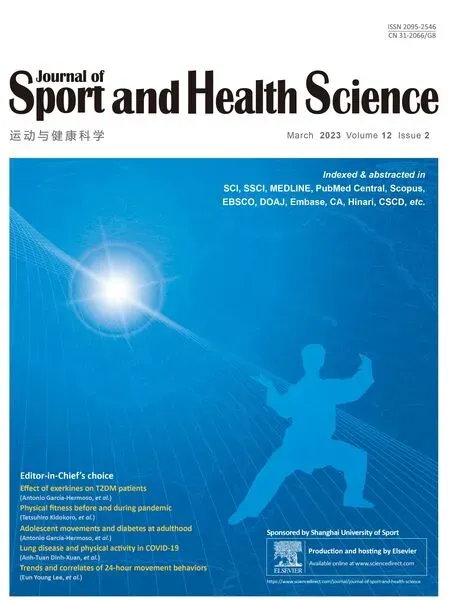 Journal of Sport and Health Science2023年2期
Journal of Sport and Health Science2023年2期
- Journal of Sport and Health Science的其它文章
- Exercise training-induced changes in exerkine concentrations may be relevant to the metabolic control of type 2 diabetes mellitus patients:A systematic review and meta-analysis of randomized controlled trials
- Stair climbing,genetic predisposition,and the risk of incident type 2 diabetes:A large population-based prospective cohort study
- Twenty-four-hour movement guidelines during middle adolescence and their association with glucose outcomes and type 2 diabetes mellitus in adulthood
- The effects of a 20-week exercise program on blood-circulating biomarkers related to brain health in overweight or obese children:The ActiveBrains project
- Dose-dependent associations of joint aerobic and muscle-strengthening exercise with obesity:A cross-sectional study of 280,605 adults
- Chronotropic incompetence is more frequent in obese adolescents and relates to systemic inflammation and exercise intolerance
